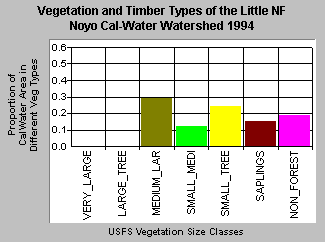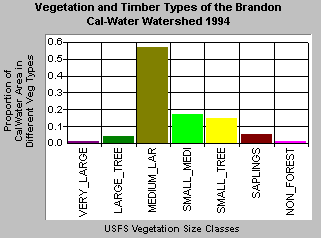
|

|
| Background | Hypotheses | Bibliography | Maps | Home |

|

|
| Background | Hypotheses | Bibliography | Maps | Home |
KRIS Web Background Pages: Vegetation Types
![]()
The 1994 Landsat imagery processed by the U.S. Forest Service Southwest Region Remote Sensing Lab is available in the KRIS Noyo Map project. It allows a quick review of seral stages in various CalWater planning units. The data from the USFS have been filtered for tree size not type and tree size is used as a surrogate for seral stage. Data from the California Department of Forestry on timber harvests is also incorporated into KRIS Noyo Maps and can be used in conjunction with the USFS vegetation classification to explore watershed disturbance. Watersheds with lower disturbance levels are more likely to have a diverse assemblage of salmonid species (Reeves et al., 1993).
The vegetation data can also be reviewed as summary charts in the KRIS Noyo database:

|

|
| The Little North Fork Noyo CalWater planning watershed had 30% Medium/Large trees according to the USFS vegetation classification based on 1994 Landsat imagery. The next most abundant categories were Small Trees (24%), Non-Forest (19%), Saplings (15%) and Small/Medium trees making up the balance. See map view of the Little North Fork Vegetation below. | The Brandon Gulch CalWater unit is in Jackson State Demonstration Forest and actually encompasses the North Fork South Fork Noyo River. The USFS stand classification data indicate that Medium/Large trees (20-29.9" diameter) comprised over half of this CalWater planning unit. Trees larger than 30 inches in diameter made of 5% of the landscape. Early seral components are lower than in the Little North Fork Noyo basin. |
![]()
References
Reeves, G.H., F.H. Everest and J.R. Sedell. 1993 . Diversity of Juvenile Anadromous Salmonid Assemblages in Coastal Oregon Basins with Different Levels of Timber Harvest. Transactions of the American Fisheries Society. Vol 122, No. 3. May 1993.
Schwind, B. 1999. USFS Thematic Mapper Landsat Vegetation Coverage Background Information. USDA Forest Service. Pacific Southwest Region Remote Sensing Lab. Sacramento, CA.
Warbington, R., B. Schwind, C. Curlis and S. Daniel. 1998. Creating a Consistent and Standardized Vegetation Database for Northwest Forest Plan Monitoring in California. USDA Forest Service. Pacific Southwest Region Remote Sensing Lab. Sacramento, CA.
![]()
| www.krisweb.com |